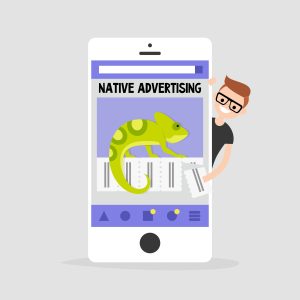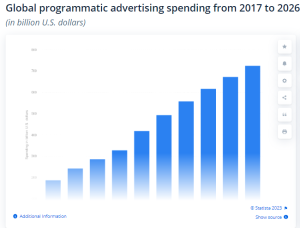The world of digital ads is constantly evolving, and it can be challenging for marketers to keep up with the latest trends. Today, the two most popular advertising strategies are programmatic display and native advertisements.
Both approaches can effectively reach your target audience but have some key differences. Let’s have a close look at programmatic vs native advertising to help you choose the best strategy for your brand.
Programmatic Display Advertising: What is it?
Programmatic display advertising is a data-driven approach to reaching audiences across the web. It uses automated technology to deliver ads to specific individuals based on their interests and online behaviors. Programmatic buying allows for highly targeted campaigns that can be adjusted in real-time, making it a highly efficient way to reach consumers.
Programmatic advertising can take many forms, including banner ads, video ads, and native ads. These can appear on websites, social media platforms, and even mobile apps. Programmatic advertising is often used for retargeting campaigns, which display ads to users who have visited a website or taken a particular action.
Additionally, you can pair programmatic displays with various digital marketing tactics to increase your ads’ ROI and customer engagement.
The following digital marketing strategies work well with programmatic advertising:
- Geofencing Marketing
- Conversion Zone Tracking
- Site Retargeting
- CRM Retargeting
- Keyword Contextual Tracking
- Event Targeting
- and more!
While programmatic advertising can be highly effective, it can also be challenging to navigate. Technology can be complex, and there are many factors to consider when setting up a campaign.
Benefits of Programmatic Display Advertising
Let’s dive into the key benefits that make programmatic advertising a game-changer:
Efficiency and Time Saving
Imagine manually negotiating ad placements across hundreds of websites – a logistical nightmare. Programmatic advertising automates this process. You set your targeting parameters and advertising budget, and sophisticated algorithms handle bidding and ad placement in real time. This frees up your team to focus on strategic campaign development and analysis.
Precise Targeting
Gone are the days of throwing ads against the wall and hoping they stick. Programmatic advertising allows you to target your ideal customers with pinpoint accuracy. You can leverage demographic data, browsing behavior, interests, and even purchase history to ensure your ads reach the most receptive audience. A laser-focused approach like this, targeting specific audiences, translates to higher engagement rates and conversions.
Cost-Effectiveness
Programmatic platforms allow you to set clear budget parameters and bidding strategies. The real-time bidding ensures you only pay for impressions that matter. Programmatic advertising also reduces ad waste by eliminating irrelevant placements, which translates to a smarter use of your advertising budget and maximizes your return on investment.
Transparency and Control
Unlike traditional methods, programmatic advertising offers complete transparency. Get real-time campaign performance insights, including things like impressions, clicks, and conversions, if you are looking for those kinds of numbers. Control at hand enables you to keep an eye on how things are progressing, improve them, and ensure they have their desired impact, among other benefits, on ads.
Scalability and Reach
Programmatic platforms open the door to a massive network of websites and apps. With a few clicks, you can expand your campaign reach to a global audience or target niche demographics within specific geographic regions. This scalability makes programmatic advertising ideal for businesses of all sizes, from local startups to established international brands.
Reduced Risk of Ad Fraud
Ad fraud is a persistent concern for advertisers. Programmatic platforms use advanced technology to recognize and avoid fraud. That involves suspicious traffic pattern detection and filtering out bots that inflate impression numbers. With reduced ad fraud, programmatic advertising makes certain that your budget finds actual humans instead of fake clicks.
Native Advertising: What is it?

Native advertising refers to a type of digital advertising that matches the form and function of the platform on which it appears. Think of native ads as a sub-section of Programmatic display with a bit more specificity and authenticity. Native ads can take many forms, including promoted content, social media posts, and in-feed ads. They are often seen on social media platforms and content websites.
The key benefit of native ads lies in their ability to provide a more organic and non-disruptive user experience. By blending in with the platform’s content, native ads tend to be less intrusive and more engaging, leading to higher user engagement and, ultimately, better campaign performance.
Additionally, these digital ads allow brands to leverage the credibility and trust associated with the platform, resulting in improved brand perception and audience reception. The contextual relevance and seamless integration of native ads make them a powerful tool for reaching and resonating with target audiences in an increasingly saturated digital ad space.
However, native ads can also be misleading, as some users may not realize they are viewing an advertisement. Ensuring clear labeling of your native ad is crucial to avoid confusion.
An important takeaway: Native ads and social media go hand in hand. Leading social media platforms like Facebook, Snap, Instagram, and Twitter have dedicated substantial efforts to creating ad experiences that seamlessly blend with their distinctive environments.
TikTok has followed suit, rapidly establishing itself as a significant player in the native ads domain since its emergence during the pandemic.
Benefits of Native Advertising
Here’s what makes native advertising such a powerful tool for brands:
Increased Engagement
A native ad isn’t just about grabbing clicks. They captivate users by mirroring the format and style of their preferred content. Imagine a captivating sponsored article seamlessly integrated into a user’s newsfeed or cleverly disguised video ads that entertain as much as they inform. This inherent intrigue translates to higher engagement, encouraging users to delve deeper and learn more about your brand.
Improved Trustworthiness
Forget the hard sell. Native advertising focuses on building trust with potential customers by providing them with valuable content, not just a sales pitch. Think informative articles, visually stunning infographics, or even entertaining quizzes – all subtly interwoven with your brand message. This subtle approach positions you as an authority in your field, fostering a sense of trust that traditional advertising often struggles to achieve.
Stronger Targeting
Gone are the days of spraying your message across the web and hoping it sticks. Native advertising platforms allow you to target users with laser precision. Leverage demographics, interests, and online behavior to ensure your ads reach the exact audience most likely to resonate with your brand.
Versatility Across Devices
The modern consumer lives a multi-device life. Be it a smartphone, tablet, or desktop computer, users expect a seamless experience. Native ads blend in well to fit any device, ensuring your message looks polished and captivating, regardless of the screen size. This device versatility guarantees you can connect with potential customers wherever they choose to consume content.
Brand Awareness and Loyalty
Native advertising isn’t a one-shot deal. Creating profound relationships with potential clients should be the focus. One way of doing this is to always avail valuable information. This way people will believe in you, trust what you say, and promote your brand over time.
Effective for All Stages of the Sales Funnel
Native advertising isn’t confined to a single stage of the sales funnel. Whether you’re aiming to generate brand awareness, capture leads, or drive conversions, native ads can be tailored to fit your specific goals. Informative articles can spark user interest, while engaging videos can nurture leads, and compelling CTAs can convert them into loyal customers. This versatility makes native advertising a powerful tool for any marketing strategy in the ad space.
Differences Between Programmatic and Native Advertising
Let’s come to programmatic vs native advertising now and explore some of the key differences between both:
Appearance
Appearance is a vital aspect in the programmatic vs native advertising battle. Programmatic ads are like billboards on the digital advertising highway. A banner ad, video ads, and even sponsored content listings often have a distinct ad format, clearly separate from the website’s content. On the other hand, native ads tend to integrate with the surrounding content easily, mimicking the style and format of the platform they appear on.
Purpose
Programmatic advertising is all about efficiency and scale. It excels at reaching a broad audience and driving actions like website visits or app downloads. It’s like a net cast wide to capture a large pool of potential customers. Native advertising, however, focuses on quality engagement. It aims to subtly educate and inform users, building trust and brand loyalty in the process.
User Experience
The paramount aspect in the programmatic vs native advertising clash. Programmatic ads can sometimes feel disruptive, interrupting the user’s flow with a sales pitch. Native ads, on the other hand, strive for a more delightful experience. Native advertising aims to inform and entertain, integrating the brand message perfectly into the user’s content consumption.
Engagement
Programmatic advertising often relies on attention-grabbing visuals or catchy headlines to generate clicks. Engagement might be fleeting, with users quickly moving on after the initial interaction. Native ads, however, foster deeper engagement. The user actively chooses to delve into the content, leading to a more meaningful connection with the brand.
Cost
Here comes the deciding factor for this programmatic vs native advertising struggle. Programmatic advertising can be a cost-effective way to reach a large audience. The cost per click (CPC), however, can vary depending on the competition and targeting parameters. Native advertising, on the other hand, often requires a higher upfront investment for content creation. However, the potential for long-term brand loyalty and engagement can lead to a higher Return on Investment (ROI) in the long run.
Flexibility
Programmatic advertising shines in its flexibility for scaling campaigns up or down quickly. It allows you to adjust targeting parameters and budget allocations on the fly. Native advertising offers a different kind of flexibility. While campaign adjustments might take more time due to content creation, native ads can be tailored to fit various stages of the sales funnel, making them highly versatile marketing tools.
Platforms
Programmatic advertising thrives on dedicated ad exchanges and Supply-side Platforms (SSPs) that connect advertisers with a vast network of websites and apps. Native advertising, on the other hand, can leverage programmatic platforms for ad delivery but often thrives on publisher-specific networks and content discovery platforms.
The Statistics of Programmatic Display and Native Advertising
The statistics of programmatic vs native advertising highlight these strategies’ effectiveness and growing popularity in the digital advertising landscape.
According to industry reports, global programmatic ad spending is anticipated to reach a staggering $558 million in 2023, showcasing a remarkable 13.1% growth compared to the previous year and nearly doubling its value since 2019. This surge can be attributed to its ability to deliver personalized and targeted ads at scale, resulting in higher engagement rates.

In terms of native advertising, studies indicate that it generates 18% higher engagement compared to a traditional banner ad. Native ads are also estimated to account for nearly 63% of all mobile display ad spending in the United States. On the flip side, 31% of US adults use ad blockers to protect their privacy.
These statistics underscore the value of programmatic and native advertising in capturing audience attention, driving conversions, and achieving campaign objectives in the dynamic digital advertising domain.
Deciding Which Approach is Right for Your Brand
When deciding between programmatic display and native advertising, several factors should be at the forefront. Your budget, target audience, and campaign goals can all play a role in determining which approach may be most effective.
Programmatic display advertising may be the better choice if you want to reach a particular audience. The data-driven approach allows for exact targeting, which can be especially effective for retargeting campaigns.
On the other hand, native advertising may be a better choice if you are looking to increase engagement and brand awareness. Native ads are often seen as more authentic and less intrusive than traditional banner ads, which can help boost click-through rates.
Best Practices for Programmatic and Native Advertising

As digital advertising continues to evolve, programmatic and native advertising have emerged as two powerful strategies for reaching and engaging audiences. While programmatic display fuses automated technology to deliver targeted ads across a wide range of websites and apps, native ads blend seamlessly with a platform’s content, providing a more organic and non-disruptive user experience. Both approaches have their strengths and can be effective when implemented correctly.
To help you make the most of programmatic vs native advertising, here are some best practices to consider:
- Define Clear Objectives: Before diving into programmatic or native advertising, defining your campaign objectives is essential. Are you aiming to increase brand awareness, drive website traffic, or generate conversions? You can tailor your strategies and metrics by clearly identifying your goals.
- Understand Your Target Audience: Understanding your target audience is crucial for successful programmatic and native campaigns. Utilize data and insights to develop detailed buyer personas, including demographics, interests, and online behavior. This knowledge will guide your ad targeting, ensuring that your messages reach the right people at the right time.
- Craft Compelling and Relevant Content: Whether you opt for programmatic or native advertising, content quality is paramount. Invest time and effort in creating compelling ad copy, visuals, and interactive elements that resonate with your audience. To test what works best, consider designing various ad formats (e.g., static, dynamic, or video) for a programmatic display.
- Leverage Data and Analytics: Programmatic advertising relies heavily on data to optimize ad delivery and targeting. Implement robust analytics tools to track key performance indicators (KPIs) such as impressions, click-through rates (CTRs), conversions, and return on ad spend (ROAS). Continuously analyze this data to identify trends, adjust targeting parameters, and refine your campaigns for maximum impact.
- Balance Automation and Human Oversight: Programmatic advertising heavily relies on automation and algorithms to manage ad placements. While automation streamlines processes, it’s crucial to maintain human oversight.
To summarize the programmatic vs native advertising clash, both are popular strategies for reaching audiences online. While each approach has its strengths and weaknesses, the key is determining which suits your brand’s goals best.
Whether you choose programmatic display or native advertising, keep in mind that high-quality content and strategic targeting are essential for a successful digital advertising campaign.


